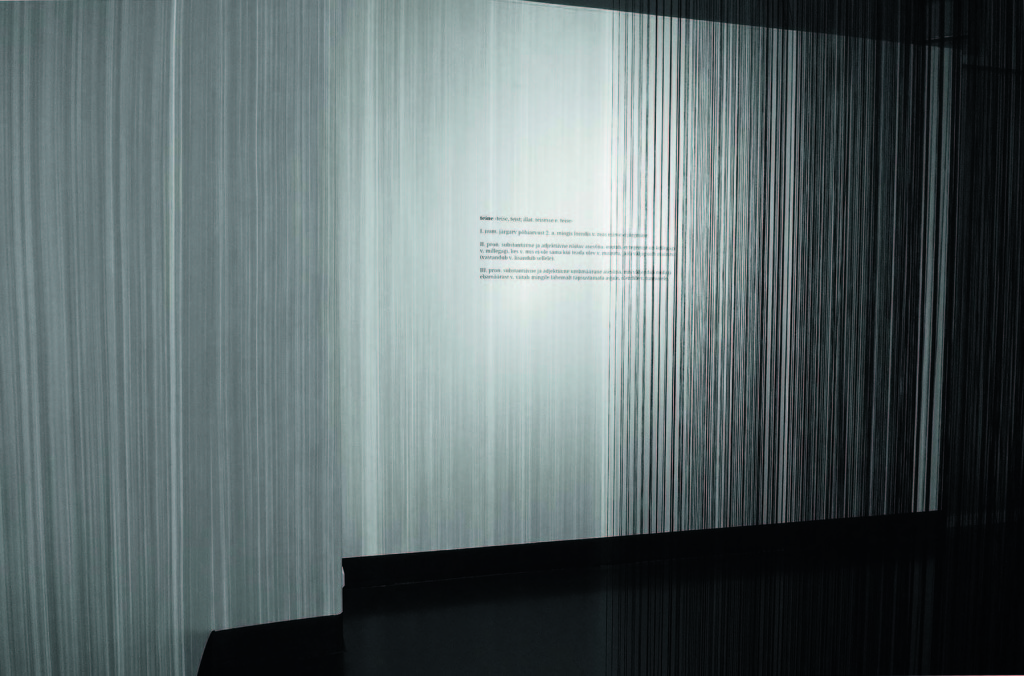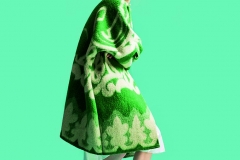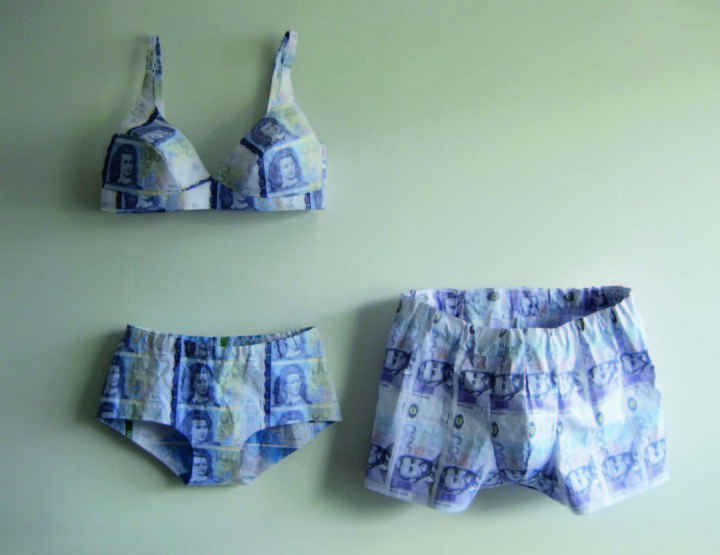“My main goal is to create experiences, haunting and memorable feelings;
to have and to keep – be it a mind-blowing space installation or
an act of wearing a simple black dress.” – Marit Ilison
April 2014, Hyères, France. I discovered Marit Ilison’s collection Longing for Sleep at the Villa Noailles (a great modernist house built by the French architect Robert Mallet-Stevens in 1925) during the International Fashion Festival. I don’t have to hide anything: under the plastic tent of the Showroom and the afternoon warmth, my first and formal impression was straightforward. Once more some coats made from granny’s blankets, whose dialogue with the sequined dresses on the same rack was quite expected, even if it seemed wise as regards colours and textures.
My second impression, under spotlights: stunning. The show, taking place in an old salt warehouse, totally catches me off guard. What seems first out of the ark takes a deliciously outdated tone, a comfy feeling. The moving figures, wrapped up in wide felt patterns, let some sheens filter through: here a reptilian dress with a petrol-shimmering play of light, there a collar letting form a bright red paste, as a metonymy of celebration.
A few months later, thinking again about the amazing work of Marit Ilison brought me to a specific triangulation, a kind of ménage à trois for a — not fairy — tale: the home lover, the clubber and the ghost.
The collection is based on kaamos, a specific part of winter when we almost don’t see the daylight in Estonia and the Scandinavian countries. A time when we would give way willingly to a nice cosy stay at home. Indeed, what hurts at once in Longing for Sleep is these large coats, which plunge us into the housing world, into domesticity. They are made from old original Soviet woollen blankets (making each piece unique). The blanket symbolizes warmth: it is the love of the inside. Comfort lined with comforting. Hence the home lover figure, who proceeds from the inside. The blanket becomes the sign of the indoors: its emblem. That means staying in the unit (the home, the bedroom, the head-box), staying without the wish to go outside. Therefore the coat’s cut is apparently simple, originating in folding. The fold and the turn of the material take over the traditional and graphically naive patterns from the blanket, patterns which symmetrically answer each other. The inner turns down the inside, over and over again. Indeed, what is more inner than a blanket? Firstly, does it have a right side and a wrong side? I don’t think so. It seems that the blanket item is after all made up of a unique inner side, like a Möbius strip. We could take Gilles Deleuze’s sentence in Le Pli (The Fold), which is about the barrocco front, which he splits into two parts, and we could apply this to the silhouettes : “it is the upper level which is closing itself, pure inside without outside, weightless enclosed interiority, covered in spontaneous folds which are finally and only a soul’s or a mind’s folds.” Then, the subject (the lover of inside), whose mind is made from many folds due to his movement within the house, is encircled by time: the Möbius strip blanket becomes the expression of duration. This means, in Bergson’s terms, “a succession of qualitative changes which are blending, penetrating each other, without any precise outlines”, as a melody we could consider as a whole, whose notes we cannot separate. Marit Ilison’s blanket ? This is the conceptual place of interpenetration and continuity. Marit Ilison’s art ? This is a real care for the material and an intelligent use of it (here a vintage blanket in this collection, there hand-cut and hand-tied hanging viscose threads in the Teine (The Other) installation).
If Longing for sleep directly echoes Chekhov’s novel Let me sleep and the agonizing indecision between the wish to sleep and the guilty of not working, the silhouettes make me think about another story, Gontcharov’s novel Oblomov: the story of a St Petersburg landowner spending his time lying on his favourite piece of furniture, a sofa. He will end his life on his sofa, forming one body with it. Облом (oblom) means break, crack: Oblomov is a man whose spring is broken. In contrast, with Marit Ilison the spring is well stretched: in spite of the coat’s weight, there is some vitality, something ready to explode, to come out. Under the Soviet granny’s blanket, there is potential and powerful youth.
The collection silhouettes waver between two figures: the home lover, who only wants to be inside, and what I call the clubber, who only wants to go out. Paradoxically (and we’ll take up this paradox again later), the going outside signs are less visible, because they are under the blanket-coat. They are mainly built up of iridescent dresses – either diaphanous and luminous, or sparkling like scales – flowing tops and pearly leggings. The straight edge of a collar makes us notice richly coloured pearl embroidery, as if these full-of-life and diaphanous clothes deposit from below and by capillary action signs of lightness and seduction, of radiance and evanescence.
The clubber’s time is the event. It is the party which punctuates the week (in this connection, Marit is also a set designer for live action and VJaying), as all these sheens, with their short appearances, punctuate the silhouettes. They are discreet fineries, moments of an unveiled light spectrum. Fragile and sumptuous. Ephemeral. These punctuations make me enter into the sense stratification of the collection. These lighted points are puncta, in the same way that Roland Barthes uses the Latin word punctum in describing a photograph (in La Chambre claire, note sur la photographie): “punctum, it is a sting, a little hole, a small task, a little cut – and also a throw of the dice. The punctum of a photograph, this is this random which, in it, stings me (but also bruises me, heartrends me).” Thus, on the coat’s wrong side, the finery becomes injury. The luminous injury, as an event in the silhouette, brings to the fore a figure born from a paradox: being stuck between two carriers, one for the home lover, whose blanket’s weight and heritage pull to the bottom, and one for the clubber, whose luminous and night attributes strive toward the top (and this makes sense with the Aurora Borealis shedding light in the kaamos night). In this way, this new figure emerges within a no-man’s land, taken over from the ambiguity of the collection’s title. Does Longing for Sleep mean the desire for sleep or sleep nostalgia? Is it an imminent rest or an insomniac wandering? In the no-man’s land of winter, Marit Ilison reveals the kaamos ghosts.
Memory of the Hyères show: the models, anti-Oblomov, a shade Pre-Raphaelite, a shade Virginia Woolf, build a bridge between generations, centuries and hours. Pictures fly out of my mind, bringing an iconographic vibration. It captures, at the same time, under my eyes, the end of the 19th century and a clubbing night: apparition of the ghost.

Marit Ilison. Teine (The Other). 2013. Conceptual site-specific installation. Solo exhibition, Hop Gallery, Tallinn, Estonia.
The collection’s strength is the creation of a new composite figure, who has no resting place, and who creates a tension between physical and conceptual material. The ghost is simultaneously the visible and the intangible. The ghost allows us to point and to reveal an absence: he creates the photogenic moment. Indeed, the collection brings to the fore an impediment: not being able to live inside and feeling oneself trapped. It is the seat of a beauty neither smooth nor violent, but specifically introspective: in the same way, the Teine installation, which earned Marit the prestigious Kristjan Raud Art Prize in the spring of 2014, set up with many hung threads the 70 000 daily thoughts of someone, developing a conceptual space to experience, in order to multiply the connection options to the world, as well as cutting all ties with the same world…until lost in a so-contemporary loneliness.
The art of Marit Ilison produces pictures. In Longing for sleep, there is something photographic, the poetry of a hard-stretched moment, between wandering and stability, between well-being and guilt, between the light spectrum and the light-ghost. The image of a double-take, at once a capture, as the camera captures the moment, and a rapture. One attracts me inside, and the other pushes me out of myself. In this way Marit Ilison’s work makes me think about Laura Veirs’s song Rapture :
With photographs
And magnetic tape
We capture
Pretty animals in cages
Pretty flowers in vases
Enraptured
(…)
Love of color, sound and words
Is it a blessing or a curse?
Enraptured
What if this controlled dramaturgy collection, made of micro-emotional cataclysms, at heart doesn’t deal with anything else than awakening? I don’t want to choose. I want both home comfort and evening excitement, a safe asset and vanity, the mainstream and the avant-garde, the injury and the bandage, the night and the daybreak. Going inside and going outside. Or going outside and going back: Longing for sleep lives in this tension. At the threshold.
The ghost’s place, in a way.
Marit Ilison (1984), conceptual fashion artist and designer, represented Estonian fashion at the London fashion week. In 2014 received the annual Kristjan Raud art award and the title Vogue TALENT 2014 from the Italian Vogue. See more at: maritilison.com







